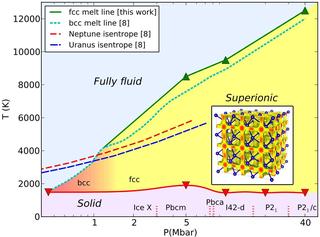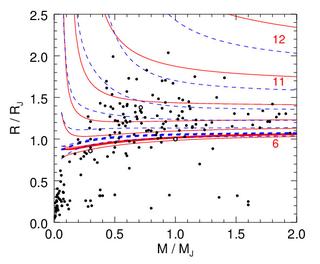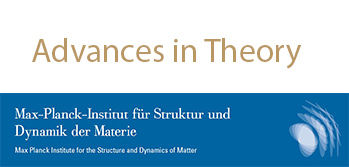Abstracts
Workshop on "Dynamics of Matter: Advances in Theory"
Anatoli Polkovnikov
Boston University
Recent advances and future prospects in non-equilibrium quantum dynamics
In this talk I will overview some recent advances in our understanding of general aspects of quantum dynamics focusing on thermally isolated systems. I will mention how ideas of thermalization through eigenstates can be used to derive equilibrium and non-equilibrium thermodynamics relations. I will discuss emergence of long-lived prethermalized states and their experimental observation. I will also discuss how ideas of universality and phase transitions can be extended to the non-eqilibrium domain. Finally I will mention some open and actively studied problems where we can expect both experimental and theoretical progress in near future.
Tamar Seidemann
Northwestern University
New Directions in Strong Field Coherent Control.
From Spinning Tops to Ultrafast Switches
Nonadiabatic alignment is a coherent approach to control over the spatial properties of molecules, wherein a short, moderately-intense laser pulse is applied to populate a broad rotational wavepacket with fascinating properties. In the limit of small isolated molecules, nonadiabatic alignment has evolved during the past 17 years into an active field of theoretical and experimental research with a rich variety of applications.
In the present talk we extend the alignment concept to complex systems, including large polyatomic molecules, dissipative media, nonrigid systems, molecular assembly, molecular conduction junctions and dense molecular ensembles. Following a review of the essential physics underlying alignment, we consider the case of asymmetric top molecules, where alignment overcomes the mechanisms that render the rotations unstable in the classical limit. Next we focus on dissipative media, and illustrate the application of rotational wavepackets as a probe of the decohering properties of the environment. We extend alignment to control the torsional motions of polyatomic molecules, and apply torsional control to manipulate charge transfer events in solutions, suggesting a potential route to light controlled molecular switches. Turning to interfaces, we introduce a route to guided molecular assembly, wherein laser
alignment is extended to induce long-range orientational order in molecular layers. Combining the nonadiabatic alignment concept with recent research on nanoplasmonics and on conductance via molecular junctions, we develop an approach to coherent control of transport in the nanoscale (Fig. 1). Finally, we explore the case of dense molecular ensembles, where alignment generalizes into a collective phenomenon that gives rise to formation of molecular assembly with long range translational and orientational order, suggesting intriguing potential applications in material design.

Fig. 1: An ultrafast, nanoscale molecular
switch based on combination of the concept of
nonadiabatic alignment with nanoplasmonics.
Reuter, Sukharev & Seideman, Phys.Rev.Lett,
101, 208303 (2008); Nature Photonics 3, 4-5
(2009); Phys.Rev. A 86 013426 (2012).
Maurits W. Haverkort
University of British Columbia
Theory of novel spectroscopic techniques:
Probing spin, charge and orbital physics.
Transition metal compounds show many fascinating properties that can be exploited in sensors, next generation electronics, and in catalysis for chemical reactions. Bulk materials exhibit high-temperature superconductivity, colossal magneto resistance, metal-insulator transitions, and many more exotic properties. Nanoclusters, surfaces, and interfaces provide us with the opportunity to combine and tune these fascinating properties, in obtaining novel functionalities. This is also the case when transition-metal ions are introduced in an organic molecule, as beautifully realized in nature with the active role Mn atoms have in the fundamental process of photosynthesis.
The astonishing electronic and magnetic phenomena stem from the delicate interplay of the spin, charge, and orbital degrees of freedom associated with the open-shell transition metal ions. Their understanding and exploitation embody the central scientific questions challenging the field of condensed matter physics. The development of novel computational approaches, as well as the deeper theoretical understanding of modern electron spectroscopies, has recently enabled us to disentangle the role of these different low-energy degrees of freedom.
In this talk I will illustrate - with a few selected examples - how theory is contributing to the refinement of modern spectroscopic techniques and to the furthering of our microscopic understanding of the spin, charge, and orbital interplay in complex materials.
Angel Rubio
Universidad del País Vasco
European Theoretical Spectroscopy Facility (ETSF), San Sebastián, Spain
Fritz Haber Institut der Max Plank Gesellschaft, Berlin, Germany
Non equilibrium dynamical processes in finite and extended systems: a TDDFT and Many-doby perspective
In this talk we will review the recent advances within density-functional and many-body based schemes to describe spectroscopic properties of complex systems with special emphasis to modeling time and spatially resolved electron spectroscopies (including transient pump-probe techniques). Pros and cons of present functionals will be highlighted and provide insight in how to overcome those limitations by merging concepts from many-body perturbation theory and time-dependent density functional theory. We will discuss some of the theoretical approaches developed in the group (and under development) for the characterization of matter out of equilibrium, the control material processes at the electronic level and tailor material properties, and master energy and information on the nanoscale to propose new devices with capabilities. We will focus on examples linked to the efficient conversion of light into electricity or chemical fuels ("artificial photosynthesis") and the design on new nanostructured based optoelectronic devices based on inorganic nanotubes, among others.
We will discuss some of the new challenges we are facing linked to what is coined as "new states of matter" that rely on two fundamental developments: i) the ability to describe open-quantum-systems out-of-equilibrium and ii) the availability of a viable “quantum optimal control theory” of their processes. The description of non-equilibrium phenomena requires answers to a number of complex questions. What are the general rules that apply to microscopic relaxation on extremely long time scales? How can non-equilibrium processes be directed at the nanoscale? How do systems search free-energy landscapes? Can artificial systems be designed to mimic biological processes? Can matter be stabilized in non-equilibrium states, such as metamaterials, glass, or graded structures? Is it possible to understand and control phase transitions, diffusion, and chemical reactions? Mastering non-equilibrium phenomena should pave the way for dealing effectively with a host of issues related to energy, climate, materials, or biology. A time-dependent description of decoherence and dissipation in many-body quantum systems will answer the above questions and open the possibility for an ab-inito simulation of a wealth of experiments that are now accessible. S ome examples include: Molecular relaxation after charge transfer in donor-acceptor complexes; relaxation of excited vibrational wavepackets in the context of photo-chemistry; real-time dynamics of formation, propagation, and decay of excitons in semiconductors, polymers and light-harvesting antenna complexes; relaxation after energy transfer between chromophores in Förster resonance-energy transfer; thermal transport and relaxation effects in molecular electronics. The goal for the newer future is to provide a detailed, efficient, and at the same time accurate microscopic approach for the ab-initio description and control of the dynamics of decoherence and dissipation in quantum many-body systems.i With the help of quantum optimal control (QOC) theory and the mastery over spectroscopy we could direct the movement of electrons, selectively trigger chemical reactions and processes, and create new materials.
Corinna Kollath
University of Geneva
Externally driven strongly correlated quantum gases
Atomic gases cooled to Nanokelvin temperatures are a new exciting tool to study a broad range of quantum phenomena. In particular, an outstanding and rapid control over the fundamental parameters, such as interaction strength, spin composition, and dimensionality allows to realize and observe many different situations far from equilibrium. Long-standing questions such as the coupling to an environment can be investigated. In my talk, I will address the question of the influence of a coupling to an environment, either dissipative or a driving field, on the system dynamics in bosonic optical lattice gases.
----
Burkhard Militzer
University of California, Berkely
First-Principles Computer Simulation of Materials in the Interiors of Giant Planets
This presentation will begin with a review of the results from NASA’s Kepler mission that has detected over 2700 planet candidates after four years in orbit. Then we will describe three recent applications of first-principles computer simulation techniques to study materials at extreme pressure and temperature conditions that exist in the interiors of giant planets. First we report a recent methodological advance in all-electron path integral Monte Carlo (PIMC) that allowed us to extend this method beyond hydrogen and helium to elements with core electrons [1]. We combine results from PIMC and with density functional molecular dynamics (DFT-MD) simulations and derive a coherent equation of state (EOS) for water and carbon plasmas in the regime from 1-50 Mbar and 104-109 K.
Second we apply DFT-MD simulations to characterize superionic water in the interiors of Uranus and Neptune. By adopting a thermodynamic integration technique, we derive the Gibbs free energy in order to demonstrate the existence of a phase transformation from body-centered cubic to face-centered cubic superionic water [2].
Finally we again use DFT-MD to study the interiors of gas giant planets. We determine the EOS for hydrogen-helium mixtures spanning density-temperature conditions in the deep interiors of giant planets, 0.2-9.0 g/cc and 1000-80000 K [3]. We compare the simulation results with the semi-analytical EOS model by Saumon and Chabrier. We present a revision to the mass-radius relationship which makes the hottest exoplanets increase in radius by ~0.2 Jupiter radii at fixed entropy and for masses greater than 0.5 Jupiter masses. This change is large enough to have possible implications for some discrepant inflated giant exoplanets.
We conclude by demonstrating that all material in the cores of giant planets, ices, MgO, SiO2, and iron, will all dissolve into metallic hydrogen. This implies the cores of Jupiter and Saturn have been at least partially eroded.

Phases of superionic water. In [2], we demonstrate the existence of face-centered cubic superionic phase.

Recalibration of the mass-radius relationship of extrasolar giant planets [3]. DFT-MD simulations (solid red lines) are compared with the model by Saumon and Chabrier (blue dashed lines).
[1] K. P. Driver, B. Militzer, "All-Electron Path Integral Monte Carlo Simulations of Warm Dense Matter: Application to Water and Carbon Plasmas", Phys. Rev. Lett. 108 (2012) 115502.
[2] H. F. Wilson, M. L. Wong, B. Militzer, "Superionic to superionic phase change in water: consequences for the interiors of Uranus and Neptune", to appear in Phys. Rev. Lett. (March 28, 2013), http://arxiv.org/abs/1211.6482.
[3] B. Militzer, "Equation of state calculations of hydrogen-helium mixtures in solar and extrasolar giant planets", Phys. Rev. B 87 (2013) 014202; "Ab Initio Equation of State for Hydrogen-Helium Mixtures with Recalibration of the Giant-Planet Mass-Radius Relation", submitted to the Astrophys. J. (2013), http://arxiv.org/abs/1302.4691.
[4] H. F. Wilson, B. Militzer, “Solubility of water ice in metallic hydrogen: consequences for core erosion in gas giant planets”, Astrophys. J. Lett. 745 (2011) 54; “Rocky core solubility in Jupiter and giant exoplanets”, Phys. Rev. Lett. 108 (2012) 111101.
Giulia Galli
University of California, Davis
It’s all about energy! The impact of theory and computation experiment?
We will discuss several problems involved in understanding and controlling energy conversion processes, including solar, photo--]electrochemical and thermoelectric energy conversion. Using examples from our recent studies based on ab initio and atomistic simulations, we willdiscuss two intertwined issues: what is the impact of theory and computation on energy related problems?
How do we take up the challenge of building much needed tighter connections between theory and experiment?
